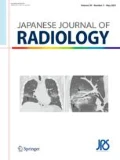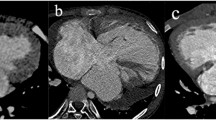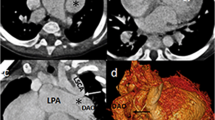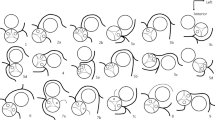Abstract
Persistent truncus arteriosus is a rare congenital cardiac disease with variable presentation. The exact preoperative diagnosis and delineation of anatomy are very important because the optimal timing and procedure for truncus arteriosus repair are decided on the basis of the morphological characteristics. Moreover, the presence of associated anomalies influences the surgical outcome and mortality in these patients. Dual-source computed tomographic evaluation with three-dimensional post-processing is highly valuable for delineating its precise morphology and to identify and characterize the associated anomalies. Also depiction of the precise aortic arch morphology and simultaneous evaluation of the airway are very useful in treatment planning. This pictorial review provides an overview of the imaging spectrum of truncus arteriosus and various associated anomalies as seen on dual-source computed tomography.















Similar content being viewed by others
References
Cifarelli A, Ballerini L. Truncus arteriosus. Pediatr Cardiol. 2003;24:569–73.
Koplay M, Cimen D, Sivri M, Güvenc O, Arslan D, Nayman A, et al. Truncus arteriosus: diagnosis with dual source computed tomography angiography and low radiation dose. World J Radiol. 2014;6(11):886–9.
Mahesh M. Advances in CT technology and application to pediatric imaging. Pediatr Radiol. 2011;41(Suppl 2):493–7.
Klink T, Müller G, Weil J, Dodge-Khatami A, Adam G, Bley TA. Cardiovascular computed tomography angiography in newborns and infants with suspected congenital heart disease: retrospective evaluation of low-dose scan protocols. Clin Imaging. 2012;36(6):746–53.
Ferdman B, Singh G. Persistent truncus arteriosus. Curr Treat Options Cardiovasc Med. 2003;5(4):429–38.
Hallermann FJ, Kincaid OW, Tsakiris AG, Ritter DG, Titus JL. Persistent truncus arteriosus. A radiographic and angiocardiographic study. Am J Roentgenol Radium Ther Nucl Med. 1969;107(4):827–34.
Mittal SK, Mangal Y, Kumar S, Yadav RR. Truncus arteriosus Type 1: a case report. Ind J Radiol Imaging. 2006;2:229–31.
Fyler DC. Origin of a pulmonary artery from the aorta (hemitruncus). In: Fyler DC, editor. Nadas’ pediatric cardiology. Philadelphia: Hanley and Belfus; 1993. p. 697–9.
Thankavel PP, Brown PS, Nugent AW. High-takeoff single coronary artery with intramural course in truncus arteriosus: prospective echocardiographic identification. Pediatr Cardiol. 2013;34:1517–9.
Mittal K, Dey AK, Gadewar R, Sharma R, Pandit N, Rajput P, et al. Rare case of truncus arteriosus with anomalous origin of the right coronary artery from the pulmonary artery (ARCAPA) and unilateral left pulmonary artery agenesis. Jpn J Radiol. 2015;33:220–4.
Khan MAA. The diagnostic approach to truncus arteriosus: medical aspects. In: Lue HC, editor. Pediatric cardiology updates. Japan: Springer; 1997. p. 23–30.
Alboliras ET, Lombardo S, Antillon J. Truncus arteriosus with double aortic arch: two-dimensional and color flow Doppler echocardiographic diagnosis. Am Heart J. 1995;129(2):415–7.
Liang PH, Chen MR, Shyur SD, Lee YJ, Lin SP, Yu MT, et al. DiGeorge syndrome with truncus arteriosus: report of one case. Acta Paediatr Taiwan. 2004;45(3):174–7.
Genç B, Okur FF, Tavlı V, Solak A. Truncus arteriosus with persistent left superior vena cava: cardiac computed tomography findings in an unrepaired adult patient. J Clin Imaging Sci. 2013;3:47. doi:10.4103/2156-7514.120787.
Conte S, Jensen T, Jacobsen JR, Joyce FS, Lauridsen P, Pettersson G. One-stage repair of truncus arteriosus, CAVC, and TAPVC. Ann Thorac Surg. 1997;63(6):1781–3.
Leschka S, Oechslin E, Husmann L, Desbiolles L, Marincek B, Genoni M, et al. Pre- and postoperative evaluation of congenital heart disease in children and adults with 64-section CT. Radiographics. 2007;27(3):829–46.
Author information
Authors and Affiliations
Corresponding author
Ethics declarations
Conflict of interest
The authors declare that they have no conflict of interest.
Ethical statement
All procedures were in accordance with ethical standards for human experimentation and the Helsinki Declaration.
About this article
Cite this article
Sharma, A., Priya, S. & Jagia, P. Persistent truncus arteriosus on dual source CT. Jpn J Radiol 34, 486–493 (2016). https://doi.org/10.1007/s11604-016-0559-x
Received:
Accepted:
Published:
Issue Date:
DOI: https://doi.org/10.1007/s11604-016-0559-x




